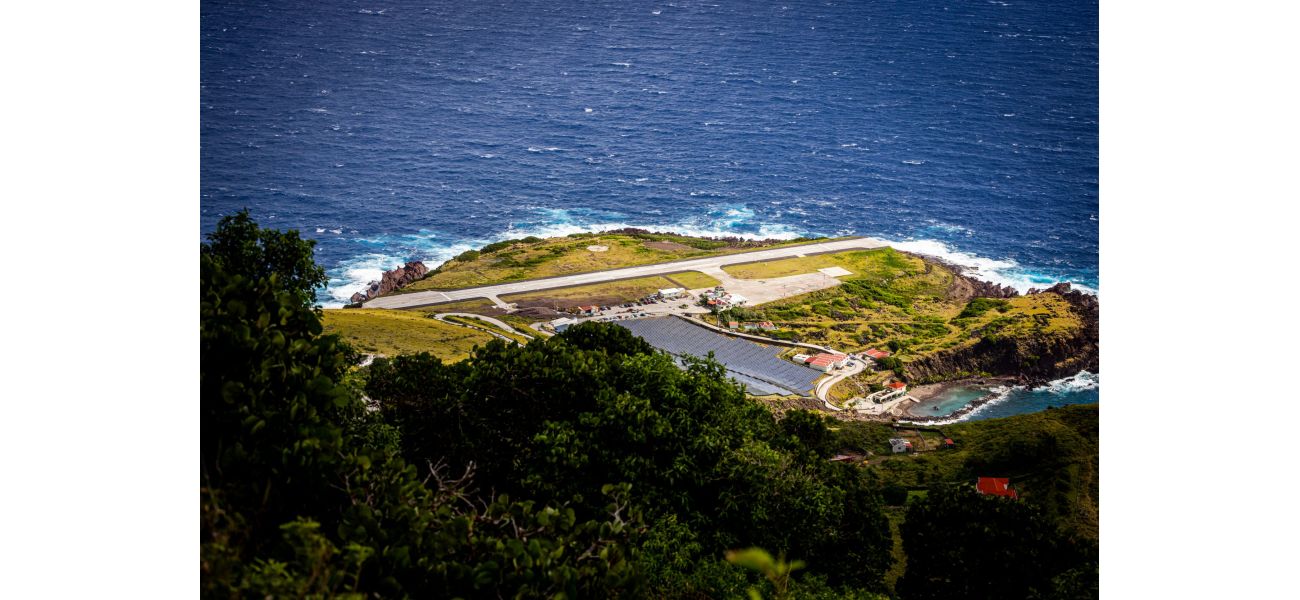Tiniest airport has runway too short for planes, requires waiver for landing.
This is a short distance of only 400 meters.
November 12th 2024.

Airports are often bustling with activity, filled with grand architecture and long runways to accommodate the constant flow of planes. However, not all airports fit this description - and surprisingly, planes don't always require a massive runway to take off and transport us to our desired destinations. Off the coast of the Dutch Caribbean Island of Saba lies Juancho E. Yrausquin Airport, considered to be the smallest airport in the world with a runway measuring only 400 metres. This unique airport is nestled between towering cliffs and the sea, making for a challenging landing. In comparison, major international airports typically have runways that exceed 3,000 metres, with some even reaching 4,000 metres in length.
The first commercial flight took off from Juancho E. Yrausquin in 1959, marking a significant milestone for the island. To put this into perspective, London's Heathrow Airport has two runways, each measuring over 3,500 metres long. Aviation enthusiasts are aware that the length of a runway dictates the size of planes that can land there - the longer the runway, the larger the plane. In the case of Juancho E. Yrausquin, it primarily caters to smaller aircraft such as the de Havilland Canada DHC-6 Twin Otter, which can seat up to 20 passengers.
However, landing at this airport is not as simple as just having a small plane. Special waivers must be obtained from the Netherlands Antilles' Civil Aviation Authority, and only propeller aircraft from regional airlines are permitted to land here. This airport's history is quite dynamic, with its opening causing a buzz on the island, and its first flight attended by the entire population. Unfortunately, the pilot of that first flight, Remy de Haenen, was subsequently banned from flying to and from the island. It wasn't until 1963 that planes were able to land here again.
The lack of a proper airport on the island became a political issue, leading the Dutch Government to agree to fund its construction in 1962. However, the airport's journey didn't end there - in 1998, Hurricane Georges caused severe damage to the main terminal, with winds reaching up to 155 miles per hour. As a result, the Dutch Government built a new terminal in 2002, which was dedicated to Remy de Haenen, the man who operated the first flight at the airport. One of the propellers from that flight is still on display at the airport today.
On the opposite end of the spectrum, the largest airport in the world is currently King Fahd International Airport in Dammam, Saudi Arabia, with an impressive size of 30 square miles. It first opened for commercial operations in 1999, but prior to that, it served as a US airbase during the Gulf War. Today, it connects passengers to 43 destinations and sees over 10 million travelers each year. However, its even more massive sibling, King Salman International Airport, is currently under construction in Riyadh, Saudi Arabia, and is set to open in five years. With six runways, it will be three times larger than King Fahd International Airport and is expected to accommodate even more passengers and airlines.
Do you have a unique airport story to share? We'd love to hear it! Please email us at [email] and let us know.
The first commercial flight took off from Juancho E. Yrausquin in 1959, marking a significant milestone for the island. To put this into perspective, London's Heathrow Airport has two runways, each measuring over 3,500 metres long. Aviation enthusiasts are aware that the length of a runway dictates the size of planes that can land there - the longer the runway, the larger the plane. In the case of Juancho E. Yrausquin, it primarily caters to smaller aircraft such as the de Havilland Canada DHC-6 Twin Otter, which can seat up to 20 passengers.
However, landing at this airport is not as simple as just having a small plane. Special waivers must be obtained from the Netherlands Antilles' Civil Aviation Authority, and only propeller aircraft from regional airlines are permitted to land here. This airport's history is quite dynamic, with its opening causing a buzz on the island, and its first flight attended by the entire population. Unfortunately, the pilot of that first flight, Remy de Haenen, was subsequently banned from flying to and from the island. It wasn't until 1963 that planes were able to land here again.
The lack of a proper airport on the island became a political issue, leading the Dutch Government to agree to fund its construction in 1962. However, the airport's journey didn't end there - in 1998, Hurricane Georges caused severe damage to the main terminal, with winds reaching up to 155 miles per hour. As a result, the Dutch Government built a new terminal in 2002, which was dedicated to Remy de Haenen, the man who operated the first flight at the airport. One of the propellers from that flight is still on display at the airport today.
On the opposite end of the spectrum, the largest airport in the world is currently King Fahd International Airport in Dammam, Saudi Arabia, with an impressive size of 30 square miles. It first opened for commercial operations in 1999, but prior to that, it served as a US airbase during the Gulf War. Today, it connects passengers to 43 destinations and sees over 10 million travelers each year. However, its even more massive sibling, King Salman International Airport, is currently under construction in Riyadh, Saudi Arabia, and is set to open in five years. With six runways, it will be three times larger than King Fahd International Airport and is expected to accommodate even more passengers and airlines.
Do you have a unique airport story to share? We'd love to hear it! Please email us at [email] and let us know.
[This article has been trending online recently and has been generated with AI. Your feed is customized.]
[Generative AI is experimental.]
0
0
Submit Comment





